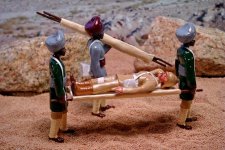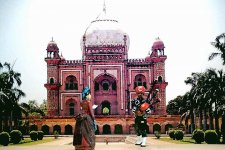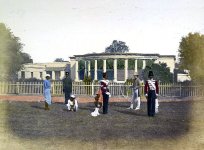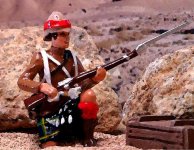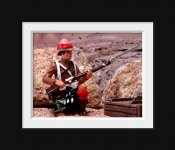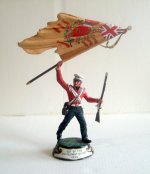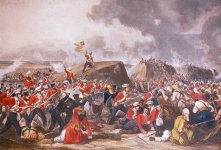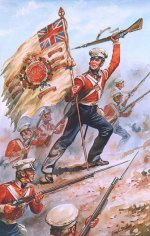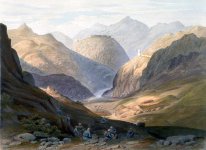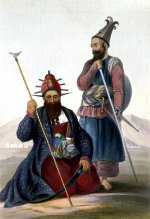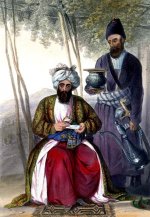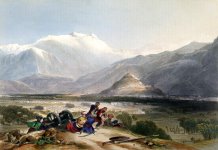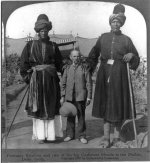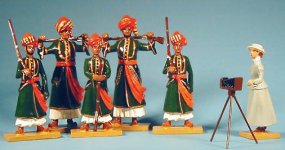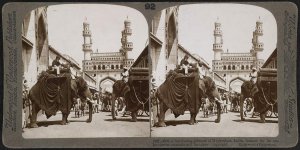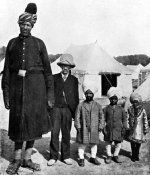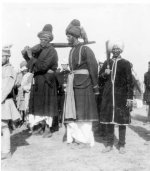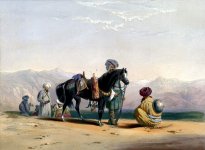You are using an out of date browser. It may not display this or other websites correctly.
You should upgrade or use an alternative browser.
You should upgrade or use an alternative browser.
Colonial India & The North-West Frontier (1 Viewer)
- Thread starter PolarBear
- Start date
PolarBear
Major
- Joined
- Feb 24, 2007
- Messages
- 6,706
Officers' Bunglaow, Barrackpore 1851
Photo by Frederick Fiebig
British Library Coll.
"A hand-coloured print of Officers Bungalow, Barakpur Park, from the Fiebig Collection: Views of Calcutta and Surrounding Districts, taken by Frederick Fiebig in 1851. Barrackpore, 24 km to the north of Calcutta on the river Hooghly, was originally permanent barracks for the British army and later became the summer residence of the British Governor Generals. Marquess Wellesley was British Governor-General in Calcutta from 1797 to 1805, and made many improvements to Barrackpore. He had the gardens of Barrackpore Park laid out in the 'English Style' and the extensive grounds contained a theatre, an aviary and a menagerie. The Park then became a popular place for leisure pursuits. Bungalows were built in the park initially as sleeping quarters for the Governor-General's staff, as Barrackpore House could not contain enough south-facing bedrooms to enable them to catch the southern cooling breeze.This is a view of a bungalow at Barrackpore with a central curved colonnade along the front. Uniformed sepoys and a European are posed in the foreground."
Photo by Frederick Fiebig
British Library Coll.
"A hand-coloured print of Officers Bungalow, Barakpur Park, from the Fiebig Collection: Views of Calcutta and Surrounding Districts, taken by Frederick Fiebig in 1851. Barrackpore, 24 km to the north of Calcutta on the river Hooghly, was originally permanent barracks for the British army and later became the summer residence of the British Governor Generals. Marquess Wellesley was British Governor-General in Calcutta from 1797 to 1805, and made many improvements to Barrackpore. He had the gardens of Barrackpore Park laid out in the 'English Style' and the extensive grounds contained a theatre, an aviary and a menagerie. The Park then became a popular place for leisure pursuits. Bungalows were built in the park initially as sleeping quarters for the Governor-General's staff, as Barrackpore House could not contain enough south-facing bedrooms to enable them to catch the southern cooling breeze.This is a view of a bungalow at Barrackpore with a central curved colonnade along the front. Uniformed sepoys and a European are posed in the foreground."
Attachments
Cardigan600
Memoriam Member
- Joined
- Jan 9, 2008
- Messages
- 1,388
Yo Troopers, Had this Sgt of the 31st Regt of Foot on ebay, have two of them. No takers for him, which surprised me, its one of Chas best models. Anyway found a small piece of paper Under the foam in the box I have for one of them from the factory. Its says its Sgt Bernard McCabe who went to India in 1840. So looked him up on the web, turns out he is the Regimental hero. At the battle of Sobraon the 1st Sikh war 10th Feb 1846, two officers were shot down carrying the Standard. So Bernard (what a name ) grabs the standard and climbs up a hill showing the standard which spurred the Regt on to victory. He was promoted to Officer class for his bravery, and of course was an Irishman
) grabs the standard and climbs up a hill showing the standard which spurred the Regt on to victory. He was promoted to Officer class for his bravery, and of course was an Irishman . Just shows what you can find out about some of your models, and fits in with Polarbear's India thread. First photo is of the model, then a painting by someone else of the battle and Bernard with the Standard, then one of Chas Staddens paintings of this brave man.
. Just shows what you can find out about some of your models, and fits in with Polarbear's India thread. First photo is of the model, then a painting by someone else of the battle and Bernard with the Standard, then one of Chas Staddens paintings of this brave man.
Bernard (what a name )lol.
)lol.
Are you taking all this in trooper lol .
.
Bernard (what a name
Are you taking all this in trooper lol
Attachments
PolarBear
Major
- Joined
- Feb 24, 2007
- Messages
- 6,706
Yo Troopers, Had this Sgt of the 31st Regt of Foot on ebay, have two of them. No takers for him, which surprised me, its one of Chas best models. Anyway found a small piece of paper Under the foam in the box I have for one of them from the factory. Its says its Sgt Bernard McCabe who went to India in 1840. So looked him up on the web, turns out he is the Regimental hero. At the battle of Sobraon the 1st Sikh war 10th Feb 1846, two officers were shot down carrying the Standard. So Bernard (what a name) grabs the standard and climbs up a hill showing the standard which spurred the Regt on to victory. He was promoted to Officer class for his bravery, and of course was an Irishman
. Just shows what you can find out about some of your models, and fits in with Polarbear's India thread. First photo is of the model, then a painting by someone else of the battle and Bernard with the Standard, then one of Chas Staddens paintings of this brave man.
Bernard (what a name)lol.
Are you taking all this in trooper lol.
Thank you for this additon to the India thread. A terrific figure indeed.
Randy
trooper
Command Sergeant Major
- Joined
- Aug 15, 2007
- Messages
- 2,173
McCabe was also responsible for a custom within the East Surrey regiment, the direct descendant of the 31st Foot. Part of the colour that he planted on the Sikh entrenchment was enclosed in the lid of the salt cellar, part of the regimental silver. When an officer joined the regiment he would be "dined in" and during the meal would be invited to "take salt with the regiment", having done so he would sign the Salt Book and thus become a fully fledged member of the regiment.
Cardigan600
Memoriam Member
- Joined
- Jan 9, 2008
- Messages
- 1,388
McCabe was also responsible for a custom within the East Surrey regiment, the direct descendant of the 31st Foot. Part of the colour that he planted on the Sikh entrenchment was enclosed in the lid of the salt cellar, part of the regimental silver. When an officer joined the regiment he would be "dined in" and during the meal would be invited to "take salt with the regiment", having done so he would sign the Salt Book and thus become a fully fledged member of the regiment.
lol OK, I bow to your superior knowledge "SIR"
Bernard.
PolarBear
Major
- Joined
- Feb 24, 2007
- Messages
- 6,706
'Afghaunistan' by Lieutenant James Rattray. CONTINUED
Rattray Plate 13 Fortress of Alimusjid, and the Khybur Pass
Rattray was part of a combined force known as the Army of the Indus. He helped man the rear-guard during the army's march from Kabul to Peshawar. The wild mountain scenery of Afghanistan suddenly surrounded them on entering the Khyber Pass from Jamrud. Their mission was to take the fortress of Ali Masjid, popularly known as the Key of the Pass, which dominated the road and was garrisoned by Dost Mohammed's troops. Rattray had taken this sketch, "and had scarcely completed it, when suddenly a report was heard, and, to my utter astonishment, walls and bastions composing the fortress blew up simultaneously in the air, like a whirlwind of sand; and so completely was it swept off from the summit of the mountain, that when the dense cloud cleared away not a vestige of the building remained."
BL
Rattray Plate 13 Fortress of Alimusjid, and the Khybur Pass
Rattray was part of a combined force known as the Army of the Indus. He helped man the rear-guard during the army's march from Kabul to Peshawar. The wild mountain scenery of Afghanistan suddenly surrounded them on entering the Khyber Pass from Jamrud. Their mission was to take the fortress of Ali Masjid, popularly known as the Key of the Pass, which dominated the road and was garrisoned by Dost Mohammed's troops. Rattray had taken this sketch, "and had scarcely completed it, when suddenly a report was heard, and, to my utter astonishment, walls and bastions composing the fortress blew up simultaneously in the air, like a whirlwind of sand; and so completely was it swept off from the summit of the mountain, that when the dense cloud cleared away not a vestige of the building remained."
BL
Attachments
PolarBear
Major
- Joined
- Feb 24, 2007
- Messages
- 6,706
Rattray Plate 14 Chief Executioner and Assistant of his Majesty, the late Shah
According to Rattray, these portraits of the seated executioner, Mohammad Shah, and his attendant, "do not show how truly grotesque and demoniacal their appearance was", which was exaggerated by "their high fantastic caps of every conceivable semblance". To add to the horror, they did not kill cleanly, but hacked at their victims and left them to public exposure. Noone could succour those being executed, or even complete the kill, because the suffering was meant as much as a deterrent as an atonement. Rattray witnessed this himself, when Mohammad Shah tortured and killed Jaun Khan, who had assassinated Rattray's best friend. Shah, a gentleman by birth, is shown holding a painted wand surmounted by a bird, indicating his status as head of a family. BL
According to Rattray, these portraits of the seated executioner, Mohammad Shah, and his attendant, "do not show how truly grotesque and demoniacal their appearance was", which was exaggerated by "their high fantastic caps of every conceivable semblance". To add to the horror, they did not kill cleanly, but hacked at their victims and left them to public exposure. Noone could succour those being executed, or even complete the kill, because the suffering was meant as much as a deterrent as an atonement. Rattray witnessed this himself, when Mohammad Shah tortured and killed Jaun Khan, who had assassinated Rattray's best friend. Shah, a gentleman by birth, is shown holding a painted wand surmounted by a bird, indicating his status as head of a family. BL
Attachments
PolarBear
Major
- Joined
- Feb 24, 2007
- Messages
- 6,706
Rattray Plate 15 Mahomed Naib Surreef, a celebrated Kuzzilbach chief of Caubul and his Peshkidmut
Mohammad Naib Sharif was a Shia chieftain from the powerful Qizilbash tribe originally from Iran. Other Afghans were mostly Sunni Muslims and Rattray wrote: "This difference in their religious tenets creates the bitterest feeling between the two sects and leads to constant bloodshed."
Sharif was a close friend of Alexander Burnes and had rescued Burnes' dishonoured corpse and given it a decent burial. He compromised himself so much due to his steadfast friendship with the British that he was constantly threatened with destruction. He left Afghanistan with the British armies in 1842 and was given a handsome stipend by the Indian Government.
His Peshkhidmat - or attendant - wears the black lambskin cap of the Iranians. Through the opening at the top peeps the red lining, like a tongue, from which the term Qizilbash, meaning red cap, is derived. BL
Mohammad Naib Sharif was a Shia chieftain from the powerful Qizilbash tribe originally from Iran. Other Afghans were mostly Sunni Muslims and Rattray wrote: "This difference in their religious tenets creates the bitterest feeling between the two sects and leads to constant bloodshed."
Sharif was a close friend of Alexander Burnes and had rescued Burnes' dishonoured corpse and given it a decent burial. He compromised himself so much due to his steadfast friendship with the British that he was constantly threatened with destruction. He left Afghanistan with the British armies in 1842 and was given a handsome stipend by the Indian Government.
His Peshkhidmat - or attendant - wears the black lambskin cap of the Iranians. Through the opening at the top peeps the red lining, like a tongue, from which the term Qizilbash, meaning red cap, is derived. BL
Attachments
PolarBear
Major
- Joined
- Feb 24, 2007
- Messages
- 6,706
Rattray Plate 16 Bala Hissar and city of Caubul with the British cantonments from the 'Ba Maroo' Hill
Kabul has been the capital of Afghanistan since 1773 and is strategically located in a narrow stretch of the Kabul River Valley near an entrance to the Khyber Pass. This made it a key area in the quest for power in the region. The British had taken it briefly in 1839 but, forced to retreat, they were ambushed and massacred.
Rattray sketched this view of the cantonments from the low hills of the village of Bibi Mahru, where many soldiers later died, writing: "our subsequent annihilation can be ascribed in the first instance to the unaccountable absence of military judgment or skill, which selected such a position for the army in the heart of a half-conquered country; a cantonment which troops could neither quit nor enter without running the gauntlet of [fire] poured into them from fortress, garden, village, hill and wall, which hemmed in ... the ill-contrived and widely-scattered lines." BL
Kabul has been the capital of Afghanistan since 1773 and is strategically located in a narrow stretch of the Kabul River Valley near an entrance to the Khyber Pass. This made it a key area in the quest for power in the region. The British had taken it briefly in 1839 but, forced to retreat, they were ambushed and massacred.
Rattray sketched this view of the cantonments from the low hills of the village of Bibi Mahru, where many soldiers later died, writing: "our subsequent annihilation can be ascribed in the first instance to the unaccountable absence of military judgment or skill, which selected such a position for the army in the heart of a half-conquered country; a cantonment which troops could neither quit nor enter without running the gauntlet of [fire] poured into them from fortress, garden, village, hill and wall, which hemmed in ... the ill-contrived and widely-scattered lines." BL
Attachments
Hi Randy,
You are presenting some extremely interesting information and I am loving every minute of it! Thanks for performing the research and sharing the information and the pictures with us. I look forward to leaning more from you about the North-West Frontier.
Warmest personal regards,
Pat
You are presenting some extremely interesting information and I am loving every minute of it! Thanks for performing the research and sharing the information and the pictures with us. I look forward to leaning more from you about the North-West Frontier.
Warmest personal regards,
Pat
PolarBear
Major
- Joined
- Feb 24, 2007
- Messages
- 6,706
Professor James Ricalton and two of his Cashmere friends at the Durbar, Delhi, India c.1903 (Library of Congress)
These giants have been reproduced by Beau Geste for their 1903 Delhi Durbar Series: Kashmiri Giants, with Gertrude Bell, Delhi Durbar, 1903 BG091
These giants have been reproduced by Beau Geste for their 1903 Delhi Durbar Series: Kashmiri Giants, with Gertrude Bell, Delhi Durbar, 1903 BG091
Attachments
PolarBear
Major
- Joined
- Feb 24, 2007
- Messages
- 6,706
James Ricalton 1844-1929 (cited above) was a school teacher and photographer from Mapelwood, NJ. A world traveler, he shot over 100,000 images including numerous stereopticon views for the publisher Underwood & Underwood. His work included war photography during the Boxer Rebellion and the Russo-Japanese War and in the early 1900 he went to India.
"Stereographic photograph of Hyderabad in Andhra Pradesh, taken by James Ricalton in c. 1903, from The Underwood Travel Library: Stereoscopic Views of India. Hyderabad was founded beside the River Musi in 1591 by Muhammad Quli Qutb Shah (r.1580-1612) as an alternative to his capital at Golconda. The town was laid out in a grid pattern with two main roads running east to west and north to south; the Char Minar sits at the intersection of these two roads. The Char Minar, or Four Towers, seen in the background of this view, was built in 1591 to mark the centre of the city. This ceremonial structure comprises four imposing arched portals with arcaded storeys and geometric screens above. The four corner minarets are crowned with domical finials. They contain spiral staircases opening onto triple tiers of balconies. This image is described by Ricalton in 'India Through the Stereoscope' (1907), "Two of the Nizam's state elephants have intruded athwart the street and obstructed our view...These two have just come out from the great archway on the left; they are being brought out in readiness to convey some traveler to Golconda." This is one of a series of 100 photographs, designed to be viewed through a special binocular viewer, producing a 3D effect, which were sold together with a book of descriptions and a map. Stereoscopic cameras, those with two lenses and the ability to take two photographs at the same time, were introduced in the mid 19th century."
"Stereographic photograph of Hyderabad in Andhra Pradesh, taken by James Ricalton in c. 1903, from The Underwood Travel Library: Stereoscopic Views of India. Hyderabad was founded beside the River Musi in 1591 by Muhammad Quli Qutb Shah (r.1580-1612) as an alternative to his capital at Golconda. The town was laid out in a grid pattern with two main roads running east to west and north to south; the Char Minar sits at the intersection of these two roads. The Char Minar, or Four Towers, seen in the background of this view, was built in 1591 to mark the centre of the city. This ceremonial structure comprises four imposing arched portals with arcaded storeys and geometric screens above. The four corner minarets are crowned with domical finials. They contain spiral staircases opening onto triple tiers of balconies. This image is described by Ricalton in 'India Through the Stereoscope' (1907), "Two of the Nizam's state elephants have intruded athwart the street and obstructed our view...These two have just come out from the great archway on the left; they are being brought out in readiness to convey some traveler to Golconda." This is one of a series of 100 photographs, designed to be viewed through a special binocular viewer, producing a 3D effect, which were sold together with a book of descriptions and a map. Stereoscopic cameras, those with two lenses and the ability to take two photographs at the same time, were introduced in the mid 19th century."
Attachments
PolarBear
Major
- Joined
- Feb 24, 2007
- Messages
- 6,706
From Gertrude Bell's Diary
07/01/1903
Wed. 7. [7 January 1903] Left the hotel about 9 and drove up to the Durbar amphitheatre - delicious and undusty[?]. All the native followers were packed outside. Met Mr Chirol and Mr Stewart and got out and walked among them photographing. Most wonderful. Ladakhis in masks, Jaipuris in coats of mail, elephant carriages belonging to Ulwar and Baroda, gold and silver guns pulled by bullocks to Scindia, enchanting Shans in big hats beating gongs, gorgeous elephants with leopards painted on their faces, musicians of all sorts, men in grey wadded armour, camel carriages, gold and silver palkis with long ......... horses and seats supported by cheetahs of silver, gorgeous covered ekkas drawn by bullocks. Met Major D.S. [Dunlop Smith] and congratulated him. They all loved being photographed. In the arena met the Martindales, Mr Landon introduced[?] Coble to me, a charming person. Sat just behind Jaipur. In the show we had armed men on stilts, dancing half naked Arabs, rearing horses (one man fell off and his horse as nearly as anything came over backwards) a reaching[?] elephant, men armed with shields and swords who went past fighting a sham fight, drummers on elephants who drummed like mad (and one blew his nose with his fingers just in front of the Viceroy) long haired Baluchis, armed men on camels, Kashmiri giants, 7 ft 4 in high, a Nabha dwarf, every fantastic thing that the mind of man could conceive. One band in uniform had a bandmaster in a long black coat who beat time, with much agitation of mind, with his walking stick, Jeend had a fine gold and silver carriage, Patiala's jibbed just in front of us and Bikaner and an aide had to go down and push the wheels - finally they took the leaders out; the Shans came past walking in their soft shoes and beating drums of a wonderful fascinating note, like a breath of silence in the midst of all the turmoil. We got in to lunch about 2; I went to sleep and at 5 we went out shopping and called on the Lawrences but they were out. Sibyl and I dined with the Gordons. Most amusing. Mr Cookson was our host. After we had drunk the King's health and the desert [sic] had been handed round the head piper came in and played a dirge round and round the table. He went out and came in again with 12 others and they played on bagpipes for half an hour. In the middle he came and stood behind the Col. drank a bumper of port at one gulp and gave our health in Gaelic. He was wounded at Elandslaagte through the arm and through the bagpipes. Talked to Susan who was dining with Tom Booth. There was lovely old regimental silver on the table. We got in at 12. Sibyl rather bad. [Written at top of second page of entry:] The naked fighting men clothed only in shield and sword belt were Nagas a tribe of warlike ascetics. Rajports[?]. A......... Vol 1 p 256
07/01/1903
Wed. 7. [7 January 1903] Left the hotel about 9 and drove up to the Durbar amphitheatre - delicious and undusty[?]. All the native followers were packed outside. Met Mr Chirol and Mr Stewart and got out and walked among them photographing. Most wonderful. Ladakhis in masks, Jaipuris in coats of mail, elephant carriages belonging to Ulwar and Baroda, gold and silver guns pulled by bullocks to Scindia, enchanting Shans in big hats beating gongs, gorgeous elephants with leopards painted on their faces, musicians of all sorts, men in grey wadded armour, camel carriages, gold and silver palkis with long ......... horses and seats supported by cheetahs of silver, gorgeous covered ekkas drawn by bullocks. Met Major D.S. [Dunlop Smith] and congratulated him. They all loved being photographed. In the arena met the Martindales, Mr Landon introduced[?] Coble to me, a charming person. Sat just behind Jaipur. In the show we had armed men on stilts, dancing half naked Arabs, rearing horses (one man fell off and his horse as nearly as anything came over backwards) a reaching[?] elephant, men armed with shields and swords who went past fighting a sham fight, drummers on elephants who drummed like mad (and one blew his nose with his fingers just in front of the Viceroy) long haired Baluchis, armed men on camels, Kashmiri giants, 7 ft 4 in high, a Nabha dwarf, every fantastic thing that the mind of man could conceive. One band in uniform had a bandmaster in a long black coat who beat time, with much agitation of mind, with his walking stick, Jeend had a fine gold and silver carriage, Patiala's jibbed just in front of us and Bikaner and an aide had to go down and push the wheels - finally they took the leaders out; the Shans came past walking in their soft shoes and beating drums of a wonderful fascinating note, like a breath of silence in the midst of all the turmoil. We got in to lunch about 2; I went to sleep and at 5 we went out shopping and called on the Lawrences but they were out. Sibyl and I dined with the Gordons. Most amusing. Mr Cookson was our host. After we had drunk the King's health and the desert [sic] had been handed round the head piper came in and played a dirge round and round the table. He went out and came in again with 12 others and they played on bagpipes for half an hour. In the middle he came and stood behind the Col. drank a bumper of port at one gulp and gave our health in Gaelic. He was wounded at Elandslaagte through the arm and through the bagpipes. Talked to Susan who was dining with Tom Booth. There was lovely old regimental silver on the table. We got in at 12. Sibyl rather bad. [Written at top of second page of entry:] The naked fighting men clothed only in shield and sword belt were Nagas a tribe of warlike ascetics. Rajports[?]. A......... Vol 1 p 256
Attachments
PolarBear
Major
- Joined
- Feb 24, 2007
- Messages
- 6,706
Rattray Plate 17 Jaunbauz, or Afghan cavalry, with horse, bearing implements for smoking
This lithograph is taken from plate 17 of 'Afghaunistan' by Lieutenant James Rattray. He wrote: "Never were a wilder, more devil-may-care set of fellows seen than the Afghan cavalry". Known as Jaanbaz (meaning 'life gamblers' ), the cavalry in the Shah's service often became mercenaries in the British army. Heavily armed, and very often professional robbers, they became soldiers when it suited them, said Rattray: "They take our service because we paid them well and regularly, but a great deal of the savoir faire was required in the management of them." He described them as "naturally a restless and independent people, and according to one of their own proverbs, ready to bear hunger, thirst, cruelty and death, but never - a master, they, by the same fate, could not endure the discipline of our regulars."
The horse in the image has a box containing a Qalyan (pipe) and smoking equipment hanging from its saddle pommel, with a pan of hot coals to light it slung under the horse's belly. BL
This lithograph is taken from plate 17 of 'Afghaunistan' by Lieutenant James Rattray. He wrote: "Never were a wilder, more devil-may-care set of fellows seen than the Afghan cavalry". Known as Jaanbaz (meaning 'life gamblers' ), the cavalry in the Shah's service often became mercenaries in the British army. Heavily armed, and very often professional robbers, they became soldiers when it suited them, said Rattray: "They take our service because we paid them well and regularly, but a great deal of the savoir faire was required in the management of them." He described them as "naturally a restless and independent people, and according to one of their own proverbs, ready to bear hunger, thirst, cruelty and death, but never - a master, they, by the same fate, could not endure the discipline of our regulars."
The horse in the image has a box containing a Qalyan (pipe) and smoking equipment hanging from its saddle pommel, with a pan of hot coals to light it slung under the horse's belly. BL
Attachments
Users who are viewing this thread
Total: 2 (members: 0, guests: 2)


